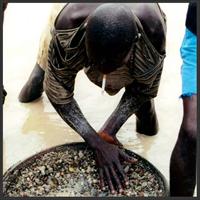SIERRA LEONE: Diamond miners choose cassava over carats

In Sierra Leone plummeting diamond prices, dwindling reserves, consistently poor working conditions and a lack of regulation are driving diamond workers to start farming, youths told IRIN.
“The future of Kono is not diamonds,” said Tamba Kakarnbanja, councillor for youths in Kono District. “It’s agriculture.”
Diamonds helped fuel the 11-year civil war that killed at least 75,000 people, injured some 10,000 and displaced almost half of Sierra Leone’s 4.5 million population according to the UN. Tens of thousands of Kono residents were forced out of their villages by rebels who wanted access to the diamond-rich land.
The global recession has slammed diamond prices in Africa, with the price of rough diamonds falling by as much as 20 percent, according to local dealers. Some industry observers say prices could fall by a further 60 percent.
Profits are plummeting for artisanal miners and large-scale corporate diamond mining firms, which have drastically cut staff across the district.
“People here say the more you shed blood, the more diamonds you get. Now we are shedding less blood, so we have fewer diamonds,” said a diamond dealer, known only as ‘Little’, in Kono’s capital Koidu.
“Living on luck”
Mohammed Diallo, 45, from Kumdoma village in Sandoh chiefdom in northern Kono, has been digging for diamonds for most of his life. “I am tired of this business," he said. "It is not constant. We have been digging this pit for three months and so far we have found nothing. Next year I am doing farming. It is more constant. You can reap what you sow. Here you are just living on luck.”
Little told IRIN: “There is very little mining now. People are still finding diamonds along the rivers, but they are smaller than before. We are finding it harder and harder to support ourselves. All of us are broke now. Most groups find a diamond every six months…if they’re lucky.”
Last year Diallo received just US$60 over the six-month season. Some steal diamonds and sell them illicitly or smuggle them across the nearby borders of Guinea or Liberia, said Abdu Diallo, Kumdoma’s supervisor.
At the Kumdoma pit men receive a bowl of rice and sauce for hours of arduous work. If they find diamonds they are paid at the end of the season. Up to 70 percent of profits go to the financier, the rest to the license-holder -- often a local chief to be split among his workers. Conditions are similar throughout the district.
Most people continue artisanal mining, “because they are living on a dream,” says Patrick Tongu, director of Kono-based non-profit Network Movement for Justice and Development.
Mining in Kono incorporates deep-pit large-scale mining, corporate shallow-pit or alluvial mining, and artisanal mining, which traditionally has employed the vast majority of locals, and is non-mechanised, low-output mining done by individuals or small groups.
Koidu Holdings, the largest firm in the area, employed 600 people in May 2008 and now retains just 60. The massive scale-back is due both to the government’s review of mining contracts and to the state of the diamond industry, according to Koidu’s spokesperson Ibrahim Kamara.
“We hope to go back to 600 one day, but madness is unfolding internationally and everyone is affected. Everyone is being sensible – people don’t want to buy luxury goods now,” Kamara told IRIN.
Farming pays
Farming can provide a higher and steadier wage than artisanal mining, says Marco Serena, country director for international NGO COOPI, which runs a programme in 32 Kono communities to help youths begin farming.
In a 2008 study of 70 youths involved in COOPI’s programme, 60 percent of them were living below the national poverty line of $1.25 per day at the beginning of the project, but 90 percent earned $2 to $3.50 per day once it was up and running.
“We are noticing with the decline in mining and with huge unemployment rates across the district, that there is much more interest in our agriculture programmes,” Serena said.
COOPI works with groups of youths – mainly aged 15 to 25 – to grow vegetables, fruits and rice. They pound cassava they produce into ‘gari’ which is mixed with water and eaten with sauce, and Serena said soon the youths will be able to process the mangoes and bananas into juice.
“These products are available for many more months [than the raw materials], and they are more valuable sale-items,” said Serena, adding that farmers can make up to a 30-percent return on their investment.
The government has also been strongly encouraging youths to return to agriculture, Serena said.
Youth councillor Kakarnbanja told IRIN: “These boys are used to hard labour and if they have the right incentives, some fertilisers, the right equipment, a bit of training to manage finance, then I think 80 percent of the youths here would choose [farming]."
Youth unemployment is at 75 percent in eastern Kono district, according to government figures. Article link
Diallo of Kumdoma village does not know how to go about raising funds to start up a farm, nor is he part of a cooperative, which is required for participating in COOPI’s grant scheme.
“I don’t know how to get there yet, but I am determined to try,” he said.
 Back and Next - Back and Next
Back and Next - Back and Next See Also - See Also
See Also - See Also